A gateway to life-changing education
CSU Spur offers varied paths for learning, inspiration story by Anthony Lane published Oct. 11, 2023Just after 9 a.m. on Saturday, Oct. 14, the moon’s shadow will edge into Colorado on its long, southeastward slide across the Americas. It will get to Denver minutes later. Visitors arriving for the month’s 2nd Saturday at CSU Spur open house may not notice in these moments a slight darkening of the sky. They will still have time to check out the campus’s green roof, its stream table, and other attractions while the annular eclipse gets underway.
By 10:30 a.m., the eclipse will be minutes from reaching its maximum in the sky southeast of Denver. Assuming a clear morning, many CSU Spur visitors will already be congregating outside. Some will don Spur-themed solar-viewing glasses that Colorado State University’s Little Shop of Physics printed for the occasion. At 10:36, the moon will block close to 80% of the sun’s glow, reducing the blazing orb to a slender crescent. Observers may laugh or tell jokes. Some may cheer, marveling at this celestial incursion into daily life.
Heather Michalak, director of the Little Shop of Physics, noticed the overlap of her astronomical calendar with the CSU Spur schedule during the summer when she and her team prepared for the academic year ahead. The program she runs is all about “gateway science,” using gizmos and creativity to inspire learners of all ages to wonder about the how and why of everything from music and movement to clouds and collisions. The CSU Spur campus, more broadly, centers on engaging visitors in research, problem solving, and learning in the areas of food, water, and human and animal health. And 2nd Saturdays are a time each month when CSU Spur comes alive with demonstrations and activities meant to kindle curiosity and highlight new career and life possibilities.
On Saturday, the sun, the moon, and Spur’s educational mission will be aligned. It’s a chance, among many, for inspiration, and perhaps a realization. That’s what it’s about, Michalak said: “We want people to release their inner scientist.”
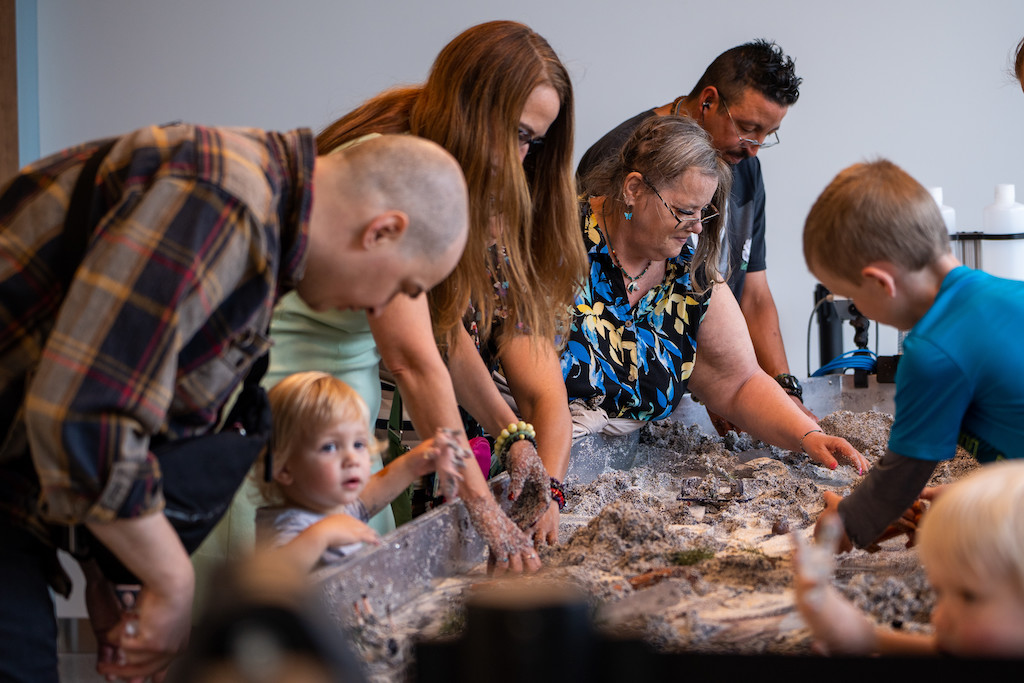
Visitors to Spur can get their hands dirty at the stream table in the Hydro building.
For Jim Bradeen, CSU’s associate vice president for Spur Strategy, the adaptable nature of programming at CSU Spur is a reflection of the campus’s focus on “life-changing education” that builds on and extends the university’s land-grant mission.
“Access is the goal, and flexibility is the vehicle we are using,” Bradeen said. “I think what is happening here is a model as we think about how we teach, what we teach, when we teach, and where we teach.”
Serving the community, building community
The informal and sometimes serendipitous learning that occurs at CSU Spur on 2nd Saturdays or during week-day visits falls on an educational spectrum that extends from school programs and adult learning to professional development and degree options. To extend Michalak’s metaphor, each pathway serves as a “gateway” to future learning, career, or life possibilities.
The location of the campus also makes it a literal gateway, one that invites connections with nearby communities and complements regional strengths in the arts, technology, and other sectors. The Spur-based master’s program in agribusiness and food innovation management, for instance, is now filling a third cohort of students poised to become leaders in a region emerging as a global hotspot for food innovation.
Among the formal learning options are student-centered introductory biology courses, LIFE 102 and 103, which combine online coursework with monthly in-person lab sessions at CSU Spur, providing flexibility for students working toward undergraduate degrees. Working professionals can instead take classes leading toward a Ph.D. in organizational learning, performance, and change, finding inspiration and support by studying alongside other cohort members in an eight-semester program.
For construction industry professionals interested in gaining new project management and leadership skills, the seven-month construction management certificate program meets at CSU Spur on Wednesday evenings and a few full Saturdays, allowing students to learn at a state-of-the-art campus where construction wrapped up less than a year ago.
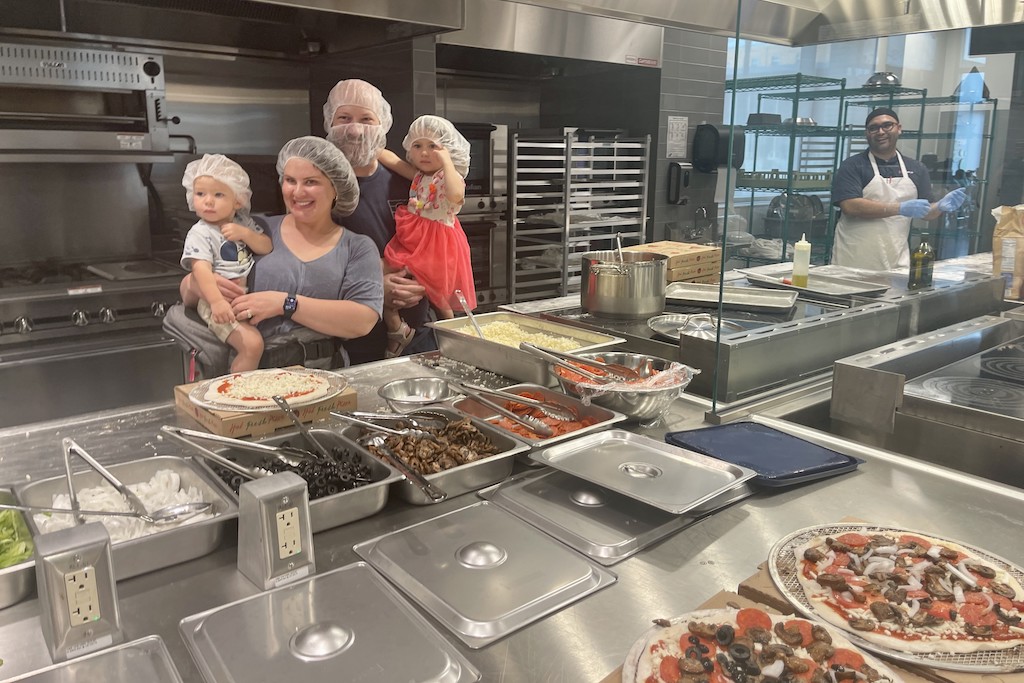
Participants in a recent community movie night at Spur made their own pizza in Terra’s kitchen.
Other programs are in the works. Michael Seman, director of CSU’s arts management program, described a certificate program scheduled to launch at CSU Spur next fall. The program is a response to the specific needs of professionals who may have been driven by creative energy rather than aspirations to lead when they started their careers in the arts.
“Often they find themselves in positions where they are running an organization, and sometimes they don’t have time to take a degree program,” Seman said. The certificate program, now available online, combines courses in policy and advocacy, events management, and community engagement in a sequence meant to equip new and aspiring arts leaders for success. The thriving arts scene in and around Denver makes CSU Spur a natural hub for the in-person program.
For 18 years, adult learners have been able to pursue their interests by taking courses, often taught by retired faculty, offered through the Osher Lifelong Learning Institute (OLLI) at CSU. Starting this spring, the program will extend to CSU Spur, and OLLI members will be able to choose from courses that include a watercolor workshop, a seminar on mindfulness, and an exploration of Ukraine, both its history and a more personal perspective.
Meredith Naughton, director of OLLI at CSU, said the goal in bringing courses to Denver is to complement offerings of an OLLI based at the University of Denver. By building connections across the two programs and with adult learners in the Denver Metropolitan area, she said, the hope is to develop another outlet for learners who may completed their careers and yet still be driven by curiosity and a desire to connect.
“I do think it’s true that you come for the class, and you stay for the community,” Naughton said.
A co-pilot for learning
CSU Spur has hosted close to 10,000 preK-12 students for facilitated visits since the campus’s first building opened in January 2022, and most days the students’ classroom teachers have been right there with them.
Educators are also regulars at the campus for conferences and professional development. In late September, for example, close to 200 educators spent much of a weekend at CSU Spur for the Colorado Alliance for Environmental Education’s (CAEE) Advancing Environmental Education Conference, taking in a demonstration of the campus’s equine sports medicine facility between sessions on ecology, climate change, and outdoor leadership pathways.
Kathryn Venzor, CSU Spur’s director of education and a CAEE board member, recognizes how the campus, with its research spaces, laboratory equipment, and conference-friendly layout, is well-suited for such professional development activities.
“It’s an amazing space where we are able to convene educators,” Venzor said.
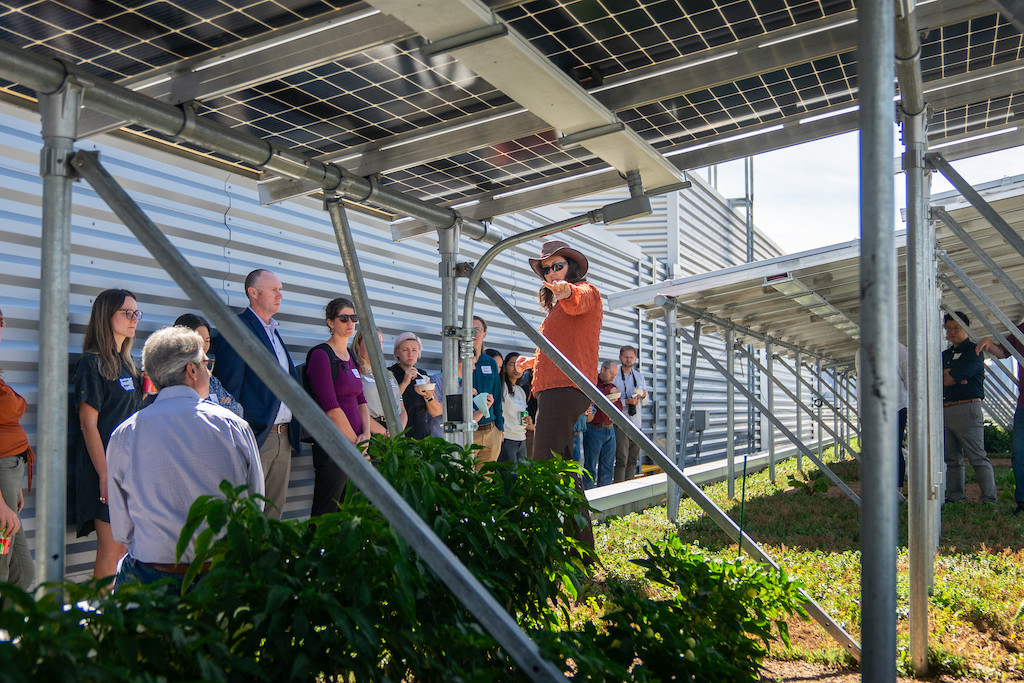
Spur recently hosted an agrivoltaics summit which explored best practices for combining photovoltaics with agriculture.
Through a partnership with Mindspark Learning, a Lakewood nonprofit, educators from nearby schools and across the region are completing professional development sessions focused on such topics as water scarcity and climate science.
CSU Spur is also a convening space for current and aspiring practitioners across sectors and shared interests. Dan Goldhamer, director of engagement and extension programs at CSU Spur, described recent activities at the campus ranging from an agrivoltaics summit at which participants explored best practices for combining photovoltaics with agriculture, to a two-day “vet science” camp for children and teenagers from across Colorado.
At the same time, the campus is enabling partnerships with local organizations that extend learning opportunities further into the community. For example, work with the Focus Points Family Resource Center, its Huerta Urbana urban agriculture program, and Denver Public Schools is helping high school students and residents learn about jobs in agriculture and business development.
As the campus reaches out to communities across Colorado, Goldhamer said, the goal is often to play the role of educational “co-pilot. We’re not telling you where to go, but helping you navigate that journey.”
That approach extends across CSU Spur. The learning kitchen in the Terra building is a focal point for regular cooking demonstrations and classes. A recent community event brought families into the kitchen to prepare their own pizzas before heading into the nearby theater to watch a movie.
Bailey Carr, a culinary dietitian with CSU’s Kendall Reagan Nutrition Center, is based at CSU Spur, and she sees how the campus can serve as a platform from which to build partnerships in the community and with organizations and businesses. Her focus is on “breaking down the barrier of kitchen intimidation” so that people of all ages feel comfortable, confident, and inspired as they prepare healthful meals.
Carr’s own educational path models how learning can be a journey rather than a destination. After completing her bachelor’s degree in dietetics, she went back to school, this time for a diploma from the Auguste Escoffier School of Culinary Arts in Boulder. “I think there’s never an age to stop learning culinary techniques,” she said.
The path of totality
This Saturday, watching the eclipse will just be one of many options for CSU Spur visitors on an innovation-themed day that will include a “Colorado food showcase” highlighting local vendors, free workshops on gardening and coding, and a range of other activities across the three-building campus at the National Western Center in north Denver.
For Michalak, this eclipse might best be seen as a teaser for the big event, a total solar eclipse on April 8, 2024, during which the face of the sun will be completely obscured for viewers along a path running from Mexico and Texas up through Maine. On Saturday, viewers will instead see an annular eclipse, which occurs when the moon is at a point in its orbit when it’s farther from earth and thus does not block the entire sun, leaving observers directly in the eclipse’s path to see a characteristic “ring of fire.”
While the path of Saturday’s eclipse will cut through the southwest corner of Colorado, viewers of annular eclipses still need solar-viewing glasses or other equipment to safely watch the action.
Total eclipses are different. In April, Michalak and her colleagues will hit the road, possibly traveling to a spot in Oklahoma or Texas where the path of totality will cross. They are looking at partnering with a school or other organization to do educational programming once they get there. Michalak has other eclipses on her calendar, including Aug. 12, 2045, when an eclipse’s path of totality will track right through Colorado.
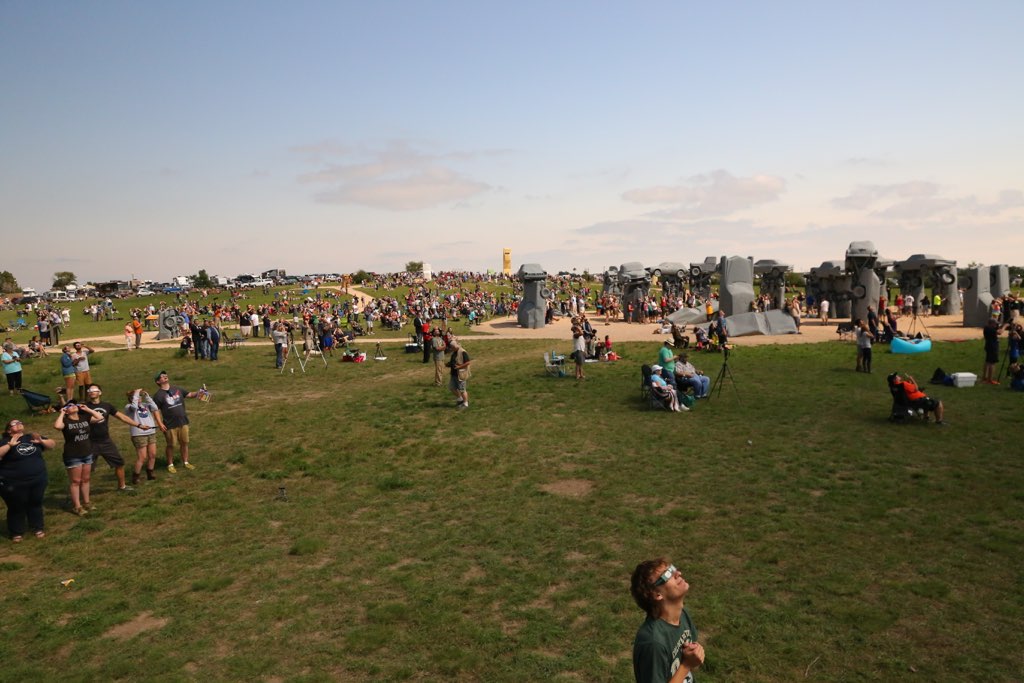
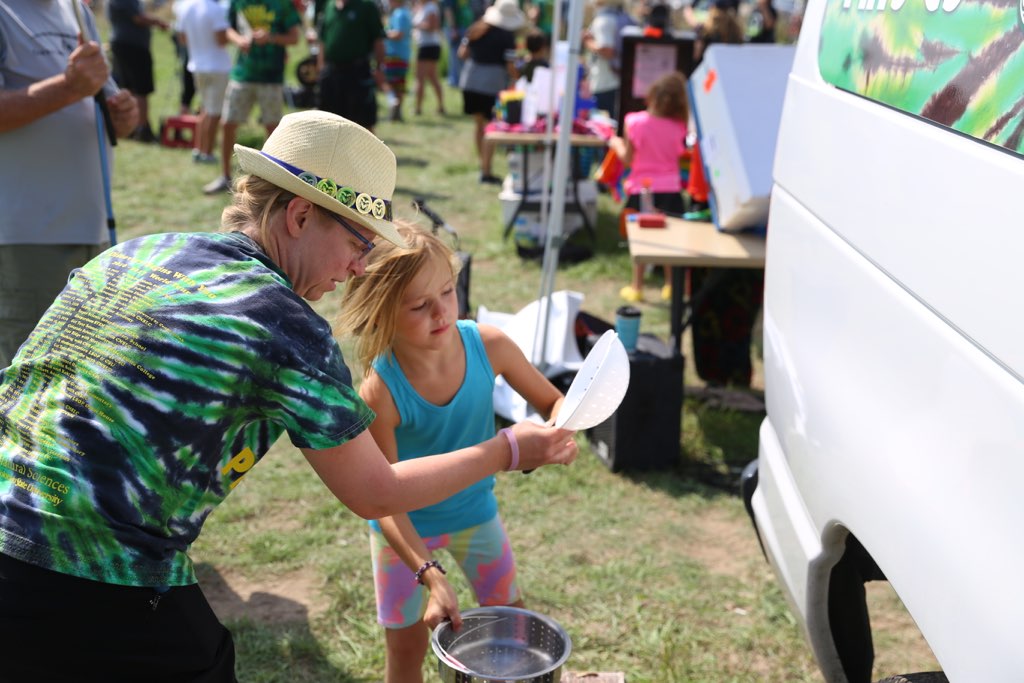
Visitors to CSU Spur this Saturday can join the eclipse watch party with Little Shop of Physics, one of many options on an innovation-themed day. These photos and the picture of a total eclipse, above, all provided by the Little Shop of Physics, were taken August 21, 2017, at Carhenge, located outside Alliance, Neb.
For the “Great American Eclipse” of 2017, Michalak was part of a crowd watching at Carhenge, located near Alliance, Neb. Her description of those few minutes points to an experience that still drives her.
“It floored me,” she said. “It’s very visceral. You are in this path, and a shadow crosses. Crickets start chirping because they think it’s night. It gets colder. You see the corona of the sun, and it’s moving. There’s this sense of shared awe.”
“It just floored me,” she said, again.
About CSU Spur
CSU Spur is a new, free learning destination open year-round in Denver, focused on engaging K-12 students, families, and visitors around food, water, and health. CSU Spur showcases the work of the CSU System campuses: CSU, CSU Pueblo, and CSU Global, while advancing knowledge on topics in food, water, health and sustainability. Spur is built upon the land-grant mission of access to education. To inspire lifelong learners to engage in important world issues, CSU Spur brings together scientists at work with youth and families, showcasing career paths, while creating a space and place for collaboration across disciplines. The CSU Spur campus provides immersive learning experiences and cutting-edge research across three buildings: Vida, Terra, and Hydro. Learn more at CSUSpur.org.